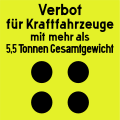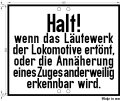Illustration of the traffic signs in the German Reich from 1925 to 1927
The picture table of the traffic signs in the German Reich from 1925 to 1927 shows the traffic signs in the German Reich during the Weimar Republic , as they were determined by the new version of the regulation on the setting up of warning signs for motor vehicle traffic of April 25, 1925 . The ordinance came into force immediately after its publication and confirmed the older legislations of 1923 and 1909. The older, confirmed official pronouncements also included the law on traffic with motor vehicles of July 21, 1923 . According to Paragraph 5a, dangerous road sections that were used for through traffic should be protected by warning signs.
Manufacturing specifications and colors
All signs, which were without exception warning signs for dangerous traffic areas, had to appear as white symbols on dark blue, circular signs. These panels were 60 to 70 centimeters in diameter. The prescribed appearance of the symbols was regulated by the International Agreement on Motor Vehicle Traffic of October 11, 1909. As long as the recognizability of the signs was not impaired, advertising was allowed on the traffic signs.
A special regulation for a more detailed standardization of the dark blue color on the boards did not yet exist. The RAL (Reichs Committee for Delivery Conditions) , which is responsible today for the true-to-color representation of traffic signs , only started work in April 1925 and presented its first color catalog in 1927.
Due to the good reflective effect and the long durability, many signs were made using the enamel technique.
The color tones and typography of the characters were not standardized, so the execution in detail was dependent on the specifications of the German states, the manufacturers and the automobile associations. The texts on the boards could also be designed differently despite official requirements.
Officially prescribed boards
International warning signs
Board for maximum speeds
Barrier boards
Panel added later until 1927
In January 1926, another barrier was made valid throughout the Reich, which was intended for heavy vehicles. Like the other barrier boards, this board was 0.50 × 0.50 meters in size and yellow. The text read a ban on vehicles with a total weight of more than 5.5 tons .
More road signs
The further signage of the streets was carried out regionally in many areas and was therefore often very inconsistent.
Local authority initiatives
Automobile Club Initiatives

Since 1912, among other things, the General German Automobile Club has been setting up place-name signs and signposts on a private initiative, as government agencies saw no need to decree modern signage that is suitable for motorists. Most of the time in the 1920s there were still the signposts and signposts from the 19th century, usually made of cast iron .
In the 1920s, the German Touring Club began setting up signposts in the most important German traffic regions. The signs had a uniform design; the lower field was reserved for the companies that had made a financial contribution to the manufacture of the tablet. Since 1925, the placing of advertisements on the traffic signs was guaranteed by law. The Bavarian Automobile Club also set up blue and white warning signs in Bavaria, which in their basic form were based on the state signs for maximum speeds.
Place name sign of
the General German Automobile Club
Fuses for crossings at rail height
Crossings were secured near the rail level by white, rectangular warning signs with a black border. These boards, which were mostly punched from sheet metal, bore inscriptions that were intended to make road users aware of the dangers and prohibitions at barrier-free and barrier-free level crossings. It was common to all warning signs that they began with the particularly capitalized word “Halt!”.
literature
- Dietmar Fack: Automobiles, traffic and education. Motorization and socialization between acceleration and adaptation 1885–1945. Leske + Budrich, Opladen 2000, ISBN 3810023868
Web links
Remarks
- ^ Reichsgesetzblatt , year 1925, No. 17, date of issue: Berlin, May 1, 1925, p. 51.
- ^ Reichsgesetzblatt , year 1925, no. 17, date of issue: Berlin, May 1, 1925, pp. 51–52.
- ↑ New marking of routes closed to heavy vehicles . In: Automobil-Rundschau 1, Volume 28, 1926. P. 28.
- ^ The German Touring Club (DTC). From a cyclist's association to a powerful motorist association . In: Deutsche Presse, 20th year (1930), p. 314 ff .; here: p. 315.

















